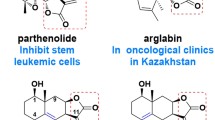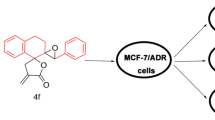Abstract
Natural products have been a great source of pharmaceuticals since ages. Vast screening of natural products from different sources has led to the discovery of plethora of chemotherapeutic drugs and other compounds for the betterment of human life. Several bioactive entities have been generated by the structural modifications of the natural products or by using the natives as key models in synthetic chemistry. Nonetheless, a number of natural compounds with potential bioactivities remain unexploited in the medicinal field due to their stringent chemical properties. Andrographis paniculata Nees., a traditional medicinal herb from family Acanthaceae is known for its multiple pharmacological activities. It’s major bioactive constituent “andrographolide”, possesses promising anticancer potential and is one such unexploited treasure. The architecture of the molecule consists of an α-alkylidene γ-butyrolactone moiety, two olefin bond [Δ8(17) and Δ12(13)], three hydroxyls at C-3, C-19, and C-14 and highly substituted trans decalin. Of the three hydroxyl groups, one is allylic at C-14, and the others are secondary and primary at C-3 and C-19, respectively. By modification of the above structural features a number of andrographolide derivatives have been synthesized. The intricacy of the molecule has always been a constraint in developing a commercialized drug, nevertheless the efforts in this direction via synthetic chemistry are still continuous and prominent. The present review highlights the chemistry and anticancer activity of andrographolide. It discusses the limitations of the molecule as a pharmacological agent. Modifications in the key molecule along different moieties has been discussed which might lead to desirable bioactive molecules. The compiled information will be helpful in further developing specific modifications in andrographolide moiety which will have significant contribution in semi synthesis of anti-cancer agents.


Similar content being viewed by others
References
Aromdee C (2014) Andrographolide: progression in its modifications and applications—a patent review (2012–2014). Expert Opin Ther Pat 24(10):1129–1138
Balachandran P, Govindarajan R (2005) Cancer—an ayurvedic perspective. Pharmacol Res 51:19–30
Brusotti G, Cesari I, Dentamaro A et al (2013) Isolation and characterization of bioactive compounds from plant resources: the role of analysis in the ethnopharmacological approach. J Pharm Biomed Anal 87:218–228
Cava MP, Chan WR, Haynes LJ et al (1962) The structure of andrographolide. Tetrahedron 18:397–403
Chao WW, Lin BF (2010) Isolation and identification of bioactive compounds in Andrographis paniculata (Chuanxinlian). Chin Med J 5:1–17
Chao WW, Lin BF (2012) Hepatoprotective diterpenoids isolated from Andrographis paniculata. Chin Med J 3:136–143
Chaudhuri PK, Singh M, Pal M et al (1999) Andrographolide and other constituents of Holmskoildia sanguine. Indian J Chem 38:632–634
Chen L, Zhu H, Wang R et al (2008) Ent-labdane diterpenoid lactone stereoisomers from Andrographis paniculata. J Nat Prod 71:852–855
Chen D, Song Y, Lu Y et al (2013) Synthesis and in vitro cytotoxicity of andrographolide-19-oic acid analogues as anti-cancer agents. Bioorg Med Chem Lett 23:3166–3169
Das B, Chowdhury C, Kumar D et al (2010) Synthesis, cytotoxicity, and structure–activity relationship (SAR) studies of andrographolide analogues as anti-cancer agent. Bioorg Med Chem Lett 20:6947–6950
De Corte BL (2016) Underexplored opportunities for natural products in drug discovery. J Med Chem. doi:10.1021/acs.jmedchem.6b00473
Devendar P, Nayak VL, Yadav DK et al (2015) Synthesis and evaluation of anticancer activity of novel andrographolide derivatives. RSC Med Chem Commun 6:898–904
Gorter MK (1911) The bitter constituent of Andrographis paniculata Nees. Rec Trav Chim 30:151–160
Harjotaruno S, Widyawaruyanti A, Sismindari S et al (2007) Apoptosis inducing effect of andrographolide on TD-47 human breast cancer cell line. Afr J Tradit Complement Altern Med 4(3):345–351
Hazra A, Bharitkar YP, Chakraborty D, Mondal SK et al (2013) Regio- and stereoselective synthesis of a library of bioactive dispiro-oxindolo/acenaphthoquino andrographolides via 1,3-dipolar cycloaddition reaction under microwave irradiation. ACS Comb Sci 15:41–48
Jada SR, Hamzah AS, Lajis NH et al (2006) Semisynthesis and cytotoxic activities of andrographolide analogues. J Enzyme Inhib Med Chem 21:145–155
Jada SR, Subur GS, Matthews C et al (2007) Semisynthesis and in vitro anticancer activities of andrographolide analogues. Phytochemistry 68:904–912
Jada SR, Matthews C, Saad MS et al (2008) Benzylidene derivatives of andrographolide inhibit growth of breast and colon cancer cells in vitro by inducing G(1) arrest and apoptosis. Br J Pharmacol 155:641–654
Jiang CG, Li JB, Liu FR et al (2007) Andrographolide inhibits the adhesion of gastric cancer cells to endothelial cells by blocking E-selectin expression. Anticancer Res 27:2439–2448
Kasemsuk S, Sirion U, Suksen K et al (2013) 12-Amino-andrographolide analogues: synthesis and cytotoxic activity. Arch Pharm Res 36:1454–1464
Kaul S, Gupta S, Ahmed M et al (2012) Endophytic fungi from medicinal plants: a treasure hunt for bioactive metabolites. Phytochem Rev 11:487–505
Khare CP (2007) Indian medicinal plants: an illustrated dictionary. Springer, Berlin
Kim TG, Hwi KK, Hung CS (2005) Morphological and biochemical changes of andrographolide-induced cell death in human prostatic adenocarcinoma PC-3 cells. In Vivo 19:551–557
Koteswara RY, Vimalamma G, Rao CV et al (2004) Flavonoids and andrographolides from Andrographis paniculata. Phytochemistry 65:2317–2321
Kumar RA, Sridevi K, Kumar NV et al (2004) Anticancer and immunostimulatory compounds from Andrographis paniculata. J Ethnopharmacol 92:291–295
Kumar P, Naik R, Karra N et al (2013) Experimental and clinical evidence of Andrographis paniculata (Roxb.) Wall. Ex Nees (Bhunimba)—a review. Int J Pharm Biol Sci Arch 4(6):1086–1093
Lahlou M (2013) The success of natural products in drug discovery. Pharmacol Pharm 4:17–31
Lee YC, Lin HH, Hsu CH et al (2010) Inhibitory effects of andrographolide on migration and invasion in human non-small cell lung cancer A549 cells via down-regulation of PI3 K/Akt signaling pathway. Eur J Pharmacol 632:23–32
Li W, Xu X, Zhang H et al (2007) Secondary metabolites from Andrographis paniculata. Chem Pharm Bull 55:455–458
Lim JCW, Chan TK, Ng DS et al (2012) Andrographolide and its analogues: versatile bioactive molecules for combating inflammation and cancer. Clin Exp Pharmacol Physiol 39:300–310
Lomlim L, Jirayupong N, Plubrukarn A (2003) Heat-accelerated degradation of solid-state andrographolide. Chem Pharm Bull 51:24–26
Luo Y, Wang K, Zhang M (2015) Synthesis of new ent-labdane derivatives from andrographolide and evaluation on cytotoxic activities. Bioorg Med Chem Lett 25:2421–2424
Maiti K, Gantait A, Mukherjee K et al (2006) Therapeutic potentials of andrographolide from Andrographis paniculata: a review. J Nat Remed 6(1):1–13
Manoharan S, Singh AK, Suresh VK et al (2012) Anti-tumor initiating potential of andrographolide in 7,12-dimethylbenz[a]anthracene induced hamster buccal pouch carcinogenesis. Asian Pac J Cancer Prev 13:5701–5708
Mishra SK, Sangwan NS, Sangwan RS et al (2007) Andrographis paniculata (Kalmegh): a review. Pharmacogn Rev 1:283–298
Nanduri S, Nyavanandi VK, Thunuguntla SS (2004a) Synthesis and structure–activity relationships of andrographolide analogues as novel cytotoxic agents. Bioorg Med Chem Lett 14:4711–4717
Nanduri S, Nyavanandi VK, Thunuguntla SS et al (2004b) Novel routes for the generation of structurally diverse labdane diterpines from andrographolide. Tetrahedron Lett 45:4883–4886
Pan L, Chai HB, Kinghorn AD (2013) Discovery of new anticancer agents from higher plants. Front Biosci 4:142–156
Panossian A, Hovhannisyan A, Mamikonyan G et al (2000) Pharmacokinetic and oral bioavailability of andrographolide from Andrographis paniculata fixed combination Kan Jang in rats and human. Phytomedicine 7:351–364
Panossian A, Davtyan T, Gukassyanetal N (2002) Effect of andrographolide and Kan Jang—fixed combination of extract SHA-10 and extract SHE-3—on proliferation of human lymphocytes, production of cytokines and immune activation markers in the whole blood cells culture. Phytomedicine 9:598–605
Patarapanich C, Laungcholatan S, Mahaverawat N et al (2007) HPLC determination of active diterpene lactones from Andrographis paniculata Nees planted in various seasons and regions in Thailand. Thai J Pharm Sci 31:91–99
Pelletier SW, Chappell RL, Prabhakar SA (1968) Stereoselective synthesis of racemic andrographolide lactone. J Am Chem Soc 90:2889–2895
Peng Y, Li J, Sun Y et al (2015) SAR studies of 3,14,19-derivatives of andrographolide on anti-proliferative activity to cancer cells and toxicity to zebrafish: an in vitro and in vivo study. RSC Adv 5:22510–22526
Prakash O, Kumar A, Kumar P et al (2013) Anticancer potential of plants and natural products: a review. Am J Pharmacol Sci 1:104–115
Preet R, Chakraborty B, Siddharth S et al (2014) Synthesis and biological evaluation of andrographolide analogues as anti-cancer agents. Eur J Med Chem 85:95–106
Puri A, Saxena R, Saxena RP (1993) Immunostimulant agents from Andrographis paniculata. J Nat Prod 56:995–999
Rajani M, Shrivastava N, Ravishankara MN (2000) A rapid method for isolation of andrographolide from Andrographis paniculata Nees (Kalmegh). Pharm Biol 38:204–209
Satyanarayana C, Deevi DS, Rajagopalan R et al (2004) DRF 3188 a novel semi synthetic analog of andrographolide: cellular response to MCF-7 breast cancer cells. BMC Cancer 4:1–8
Sheeja K, Kuttan G (2007) Activation of cytotoxic T lymphocyte responses and attenuation of tumor growth in vivo by Andrographis paniculata extract and andrographolide. Immunopharmacol Immunotoxicol 29:81–93
Sheeja K, Shihab PK, Kuttan G (2006) Antioxidant and anti-inflammatory activities of the plant Andrographis paniculata Nees. Immunopharmacol Immunotoxicol 28:129–140
Shi MD, Lin HH, Chiang TA et al (2009) Andrographolide could inhibit human colorectal carcinoma Lovo cells migration and invasion via down-regulation of MMP-7 expression. Chem Biol Interact 180:344–352
Sirion U, Kasemsook S, Suksen K, Piyachaturawat P et al (2012) New substituted C-19-andrographolide analogues with potent cytotoxic activities. Bioorg Med Chem Lett 22:49–52
Smith AB, Toder BH, Carroll PJ (1982) Andrographolide: an X-ray crystallographic analysis. J Crystallogr Spectrosc Res 12:309–319
Song Y, Xin Z, Wan Y et al (2015) Synthesis and anticancer activity of some novel indolo[3,2-b]andrographolide derivatives as apoptosis-inducing agents. Euro J Med Chem 90:695–706
Suo XB, Zhang H, Wang YQ (2007) HPLC determination of andrographolide in rat whole blood: study on the pharmacokinetics of andrographolide incorporated in liposomes and tablets. Biomed Chromatogr 21:730–734
Szychowski J, Truchon JF, Bennani YL (2014) Natural products in medicine: transformational outcome of synthetic chemistry. J Med Chem 57:9292–9308
Thakur AK, Chatterjee SS, Kumar V (2015) Adaptogenic potential of andrographolide: an active principle of the king of bitters (Andrographis paniculata). J Tradit Complement Med 5:42–50
Varma A, Padh H, Shrivastava N (2011) Andrographolide: a new plant derived antineoplastic entity on horizon. Evid Based Complement Alternat Med 815390:1–9
Wei S, Tang Y, Hua H et al (2013) Discovery of novel andrographolide derivatives as cytotoxic agents. Bioorg Med Chem Lett 23:4056–4060
Wong CC, Hui S (2016) SRJ09, a promising anticancer drug lead: elucidation of mechanisms of antiproliferative and apoptogenic effects and assessment of in vivo antitumor efficacy. Pharmacol Res 107:66–78
Xia YF, Ye BQ, Li YD et al (2004) Andrographolide attenuates inflammation by inhibition of NF-kappa B activation through covalent modification of reduced cysteine 62 of p50. J Immunol 173:4207–4217
Xu HW, Zhang J, Liu HM, Wang JF (2006) Synthesis of andrographolide cyclophosphate derivatives and their antitumor activities. Synth Commun 6:407–414
Yang L, Wu D, Luo K (2009) Andrographolide enhances 5-fluorouracil-induced apoptosis via caspase-8-dependent mitochondrial pathway involving p53 participation in hepatocellular carcinoma (SMMC-7721) cells. Cancer Lett 276(2):180–188
Yu C, Zhao Y, Chen G (2013) Swertia pseudochinensis, a new plant source of andrographolide. Chem Nat Compd 49:119–120
Zhang XF, Tan BK (2000) Anti-diabetic property of ethanolic extract of Andrographis paniculata in streptozotocin-diabetic rats. Acta Pharmacol Sin 21:1157–1164
Zhou J, Ong CN, Hur GM et al (2010) Isolation and identification of bioactive compounds in Andrographis paniculata (Chuanxinlian). Biochem Pharmacol 79:1242–1250
Acknowledgments
The authors would like to acknowledge Director, School of Biotechnology and Co-ordinator, Bioinformatics Centre, School of Biotechnology, University of Jammu for facilities. VS would like to thank Department of Science and Technology, Government of India for funding under WOS-A Project [SR/WOS-A/CS-111/2013 (G)]. Dr. Parthasarthi Das and Dr. Debaraj Mukherjee from Indian Institute of Integrative Medicine, C.S.I.R. Jammu, are also acknowledged for their helpful guidance.
Author information
Authors and Affiliations
Corresponding authors
Rights and permissions
About this article
Cite this article
Sharma, V., Sharma, T., Kaul, S. et al. Anticancer potential of labdane diterpenoid lactone “andrographolide” and its derivatives: a semi-synthetic approach. Phytochem Rev 16, 513–526 (2017). https://doi.org/10.1007/s11101-016-9478-9
Received:
Accepted:
Published:
Issue Date:
DOI: https://doi.org/10.1007/s11101-016-9478-9




